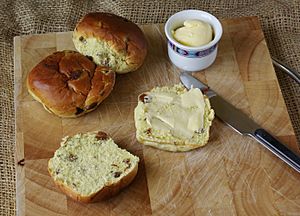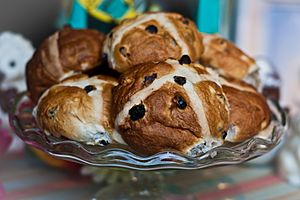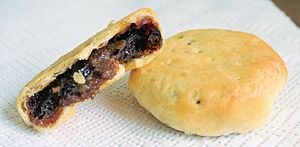Zante currant facts for kids
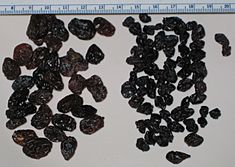
Left: Thompson Seedless grape raisins. Right: Zante currants.
|
|
| Nutritional value per 100 g (3.5 oz) | |
|---|---|
| Energy | 1,220 kJ (290 kcal) |
|
77 g
|
|
| Sugars | 62.3 g |
| Dietary fiber | 4.4 g |
|
0.22 g
|
|
|
Protein
|
3.43 g
|
| Vitamins | Quantity
%DV†
|
| Thiamine (B1) |
14%
0.16 mg |
| Riboflavin (B2) |
12%
0.142 mg |
| Niacin (B3) |
10%
1.615 mg |
| Pantothenic acid (B5) |
1%
0.045 mg |
| Vitamin B6 |
23%
0.296 mg |
| Folate (B9) |
3%
10 μg |
| Choline |
2%
10.6 mg |
| Vitamin C |
6%
4.7 mg |
| Vitamin E |
1%
0.11 mg |
| Minerals | Quantity
%DV†
|
| Calcium |
9%
88 mg |
| Iron |
14%
1.88 mg |
| Magnesium |
10%
36 mg |
| Manganese |
16%
0.345 mg |
| Phosphorus |
14%
99 mg |
| Potassium |
26%
777 mg |
| Sodium |
3%
43 mg |
| Zinc |
4%
0.37 mg |
|
Link to USDA Database entry
|
|
| †Percentages estimated using US recommendations for adults. | |
Zante currants are small, sweet, and seedless raisins. They come from a special type of grape called Black Corinth (Vitis vinifera). You might also hear them called Corinth raisins or just currants outside the United States.
The name "Zante" comes from the Greek island of Zakynthos (Zante). This island was once a major place where these grapes were grown and sent out to other countries. It's important to remember that Zante currants are not related to blackcurrants, redcurrants, or white currants. Those are berries from different plants, not grapes.
Contents
A Look Back in Time
Zante currants are one of the oldest known types of raisins. People have been writing about these grapes for a very long time. The first known mention was around 75 AD by an ancient writer named Pliny the Elder. He described them as tiny, juicy grapes with thick skins.
About a thousand years later, these raisins became important for trade. Merchants from Venice started buying and selling them with Greek farmers. In the 1300s, they were sold in England as Reysyns de Corauntz. The name "raisins of Corinth" was used in the 1400s, because the Greek city of Corinth was a main port for sending them out. Over time, the name slowly changed to just "currant."
By the 1600s, most of the trade moved to the Ionian Islands, especially Zakynthos. This is how they got the name "Zante currant."
Zante Currants in the U.S.
People first tried to bring the Black Corinth grape to the United States in 1854. The first successful vineyards were started in California in 1861. This was done by Colonel Agoston Haraszthy.
Around 1901, David Fairchild from the USDA brought high-quality Black Corinth cuttings from Greece. He started the first farms in the U.S. to grow them for sale. However, another type of grape, the Thompson Seedless, was more popular. So, American production of Zante currants stayed small until the 1920s and 1930s.
Later, Zante currants became more popular because they could be sold for higher prices. Farmers also found better ways to grow them, like a method called girdling. By 1936, about 3,000 acres (1,200 ha) of land was used to grow these grapes.
What Zante Currants Look Like
Wild grape plants can have male and female flowers on separate plants. The Black Corinth grape is mostly a "male" type. Its flowers have male parts that produce pollen, but the female parts are very small.
The bunches of Black Corinth grapes are small. They usually weigh about 6.3 oz (180 g). The grapes themselves are tiny, weighing about 0.012–0.021 oz (0.34–0.60 g). They are round and have a reddish-black color. The skin is very thin, and the inside is juicy and soft. They usually don't have seeds, except for a few larger grapes sometimes.
When these grapes are dried into raisins, they become dark brown or black. Each dried raisin weighs about 0.0032–0.0049 oz (0.091–0.139 g). The leaves of the plant are medium-sized and shaped like a heart.
Growing Zante Currants
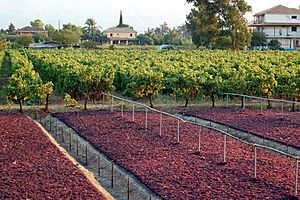
Growing Black Corinth grapes to get enough fruit needs careful work. In olden times, farmers used a method called girdling. This helped the seedless grapes grow bigger and produce more fruit. Later, a plant hormone called gibberellic acid was discovered. It could do the same job with less effort.
The Black Corinth grape plant can easily get a disease called powdery mildew. It can also get other diseases like downy mildew and black rot.
Today, Greece is still the main country that produces Zante currants. It grows about 80% of all Zante currants in the world. California, South Africa, and Australia grow most of the rest.
How We Use Zante Currants
In many English-speaking countries, Zante currants are simply called "currants." They are a popular ingredient in traditional baked goods and puddings.
These dried grapes have been used in British cuisine for hundreds of years. They were brought from the Mediterranean as a sweet treat long before cane sugar was common. Along with raisins and sultanas, they are used in many classic recipes. These include fruitcakes, currant buns, teacakes, Eccles cakes, Saffron cakes, bread and butter pudding, spotted dick, Welsh cakes, Bara brith, Christmas pudding, and mince pies. They are also a main part of currant slice and currant cake.
You can often find Zante currants sold in bags of "mixed dried fruit."
Unlike blackcurrants, Zante currants don't have a lot of vitamin C. The fresh grapes that Zante raisins are made from are very small and sweet. They have a strong flavor for a grape. Black, White, and Red Corinth grapes are sometimes sold as "Champagne grapes" in special stores in the U.S. However, they are not used to make Champagne wine.
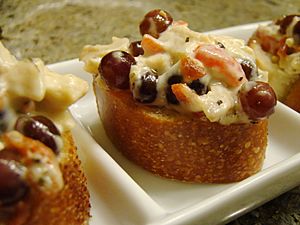
Important Note for Pet Owners
Just like grapes and other raisins, Zante currants can be harmful to dogs. Eating even a small amount can make dogs very sick and cause kidney failure. If a dog eats Zante currants, it's important to get help from a vet right away.
See also
 In Spanish: Corinto (uva) para niños
In Spanish: Corinto (uva) para niños


